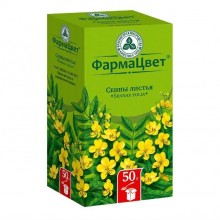



Senna leaves - a laxative of plant origin. Senna leaves contain dianthron glycosides (about 3%) - sennosides A, A1, B-G; small amount of anthraquinone glycosides, incl. aloe-emodina and rein 8-glycosides; about 10% mucus; flavonoids, incl. camperol derivatives; naphthalene glycosides.
Stimulates colon motility, causes normal stools 8-10 hours after ingestion. Selectively acts on the colon, restores the normal functioning of the intestine, does not cause addiction and does not affect digestion.
Constipation due to hypotension and sluggish peristalsis of the colon. Regulation of stool with hemorrhoids, proctitis, anal fissures; spastic and atonic constipation of various etiologies.
Leaves of senna normifolia
Senna leaves is marketed under different brands and generic names, and comes in different dosage forms:
| Brand name | Manufacturer | Country | Dosage form |
|---|---|---|---|
| Senna leaves | Krasnogorskleksredstva | Russia | Other |
| Senna leaves | Krasnogorskleksredstva | Russia | tea bags |
No customer reviews for the moment.
2 tablespoons of the leaves are placed in an enamel bowl, pour 200 ml (1 cup) of hot boiled water, cover with a lid and heat on a boiling water bath for 30 minutes, then incubate at room temperature until completely cooled, filter, squeeze the remaining raw material. The volume of the resulting broth is brought to 200 ml with boiled water. Administered orally on 1/2 glasses in the evening after food. The course of treatment is 2-3 weeks. Before using the broth is recommended to shake.
Maybe: flatulence, colicky abdominal pain.
With prolonged use, especially in high doses, - loss of electrolytes (mainly potassium), albuminuria and hematuria, deposition of melanin in the intestinal mucosa, damage to the intermuscular plexus.
Be wary when using diseases of the liver and / or kidneys. Can be used for preoperative patient preparation.
Studies and clinical trials of Senna leaves (Click to expand)